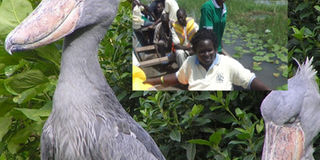Opeta’s bird watching site

Local bird watchers aboard the only motorised boat on Lake Opeta. Photo by SIMON PETER EMWAMU
A journey to Opeta Shoebill watching site is a daunting affair in the rainy seasons. The roads leading to Lake Opeta are nothing but merely cattle paths where herdsmen pass to take their animals to water.
But despite that, it remains a gazetted Ramsar Site in eastern Uganda, a home to the rare bird species found in Katakwi District.
At this time of the year, it’s a real hurdle to gain entry to Opeta. It involves winding through the muddy cattle path on motorcycles. Anything less of that denies you easy access to this site, which habours the Shoebill stork. The bird watching is at its peak at the end of the year, when rains and accumulated waters at the roadsides recede.
Untapped gem
The dream among the tour guides in this area, to make Opeta a vibrant tourist destination for bird watching, is visible. A well maintained tourist resting shade built by Conserve Uganda is evident, but beyond this, they haven’t done much to fix the road connectivity which remains a stumbling block.
Despite being a remotely perceived tourist destination, Opeta presents a serene environment that by far is admirable by tourists on a holiday vacation. The winds blowing through its green marshes from Karamoja and from the glaring Mt Elgon, brings a cool atmosphere allover Opeta’s greenery vegetation.
A watching expedition, involves venturing out for longer travel distances on rickety boats, snaking through water marshes into the heart of Opeta’s waters covered by a green and purpling water lilies, according to Patrick Elungant, a tour guide.
My experience from the tale of Elungant wasn’t any different. For the second time this year, I ventured out for a birding expedition with colleagues last Saturday in company of a young tour guide, Walter Emukoki.
A mission of patience
The narrow waterways cutting through the marshes provide a gateway to the hidden homes of the birds, before opening up into the larger and deeper fresh waters of this lake, where fishing is also the major activity.
The transparent marshes, we travel through, provide easy visibility at the low lying level bed of the floating vegetation, sights of the Fox waiver birds are common, but our intended mission was the shoebill, surprisingly it was prolonged by the swelling waters at there would be habitants.
My guide Emukoki runs out of patience after 6 hours of rowing. “It is a rainy season and these birds have now gone into hiding. The best we can do is to sail back to the shore and try another day,” he suggested.
Quite disappointed, we sail back to the shore, luckily as we disembarked off our dugout boat, the sight of the shoebill resting at the shoreline evidently pronounced its presence. The dark grey feathered bird with its shoe-beak shape appeared but shortly fled upon seeing us.
Looking fairly exhausted, Emukoki says it’s often common to venture out to watch the fascinating birds deep into the marshes of Opeta but fail to see any in their suspected habitants, but later find them in unexpected shores.
Classified as a bird watching site by the ministry of Tourism, Charles Ichohor, the executive director Conserve Uganda, says Opeta remains home to the famous iconic shoebill, though lately their visibility has become rare.
Distinct features
According to Ichogor, the fascination about the bird is that its solitary nature extends to its breeding habits, with often its nests typically occurring at less than three nests per square kilometre.
He says, at a very close range, the bird can easily be identified by its unique feathers, in flight, its unique beak cannot be seen, its features are distinctive medium blue –grey, also its tail is the same colour as its wings, and that under poor viewing conditions, its size and wingspan distinguishes it from other birds.
“Its wings are held flat while soaring, it flies with its neck retracted, its flapping rate is only at 150 flaps a minute, lower than any other birds except for larger storks,” Ichogor explains.
Interestingly, he says when flashed, the bird usually tries to fly for 100-500 metres. To Ichogor, a shoebill easily fetches about $50 (about Shs150,000) for a non-Ugandan tourist.
Unique bird specie
The shoebill is a tall bird, with a typical height ranging between 110 to 140 cm and some specimens reaching as much as 152 cm.
A male will weigh on average around 5.6Kg and is larger than a typical female of 4.9Kg. The signature feature of the species is its huge, bulbous bill, which is straw-coloured with erratic greyish markings.
The sharp edges in the mandibles help the shoebill to decapitate their prey and also to discard any vegetation after prey has been caught.
It can survive for about 30 plus years. It is resident in South Sudan, western Ethiopia, Uganda, Rwanda, eastern DR Congo, western Tanzania and northern Zambia, with records also from Central African Republic, Burundi and Kenya.




